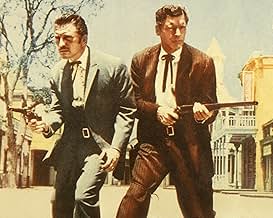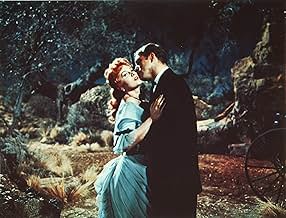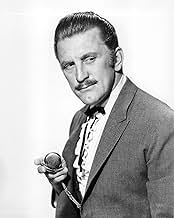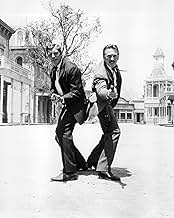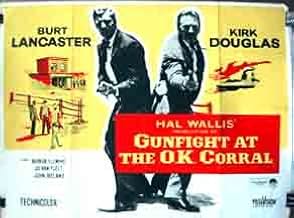Lawman Wyatt Earp and outlaw Doc Holliday form an unlikely alliance which culminates in their participation in the legendary Gunfight at the O.K. Corral.Lawman Wyatt Earp and outlaw Doc Holliday form an unlikely alliance which culminates in their participation in the legendary Gunfight at the O.K. Corral.Lawman Wyatt Earp and outlaw Doc Holliday form an unlikely alliance which culminates in their participation in the legendary Gunfight at the O.K. Corral.
- Nominated for 2 Oscars
- 3 wins & 4 nominations total
Ted de Corsia
- Shanghai Pierce
- (as Ted DeCorsia)
- Director
- Writers
- All cast & crew
- Production, box office & more at IMDbPro
Featured reviews
This is strictly Hollywood. If one reads even the most fundamental biographies of the Earps and their associates, we come to realize that their feud with the Clantons is overblown by writers who wished to satisfy an audience. The Earps and Doc Holliday were far from perfect enforcer's of the law. Wyatt was as much a politician as he was a lawman, having on many occasions to try to appease a population that didn't especially like him. Doc Holliday was a user and abuser and a very sick man. The Earp brother had their own problems. One of the foibles, especially of Wyatt, was being bad judges of women. This film makes them saviors and, in the Western tradition, black and white. The shootout is a lot of fun as is the suspense leading up to it. It's certainly not a biopic, but it's a really fun Western.
One of Hollywood's major offerings of 1957, "Gunfight" contains all the ingredients one would expect of a blockbuster - big stars, big budget and a storyline calculated to capture the public's imagination. For me, however, the film doesn't quite work. In the final analysis, the whole thing is a little too sluggish, a little too formulaic.
To be sure, it contains fine things. Burt Lancaster is stolid and unyielding as hard lawman Wyatt Earp. Sturges films him with the camera at ground level as he rides onto the screen, making him seem superhuman in his larger-than-life moral certainty. He faces down the armed drunk without the faintest twitch of fear, the embodiment of a strong, righteous enforcer of the law. The friendship between the paragon and the wastrel is cleverly done, with Earp and Holliday (Kirk Douglas) each seeing something to admire in the other, very different, man. Character is also to the fore as a plot-driver when Kate Fisher (Jo Van Fleet) is forced by the dynamics of her relationship with the Doc into ever more wretched behaviour. By comparison, the Earp-Laura love story is cold and staid. Both Lancaster and Rhonda Fleming are terrific to look at, but hard to warm to. Though the film takes an eternity to get to the shoot-out which is its raison d'etre, when the climax finally comes the suspense is built superbly. In a nice symmetry, we see the women of both sides dreading the fatal clash as Ma Clanton and Virgil's wife separately mourn the departure of their respective menfolk. Douglas made a career out of playing generous-spirited bad guys, and one of the best things in this film is Doc Holliday's heroic effort of will, rising from his sickbed to stand beside his friend in the face of mortal danger. Shot in a rich Technicolor palette, the film's images are strong and clean, and at times even beautiful, for example the barn fire, or the approach of the Earp faction, with Cotton standing facing them, his body framed by the corral building.
Other elements are not so well done. Wyatt is too unrelenting a hard man to win the audience's unqualified sympathy, as in the scene when he tells the all-too-human Cotton, "If you can't handle it any more, turn in your badge." The Frankie Laine ballad, almost de rigeur in 1950's westerns, is simply not up to scratch ("Boot Hill, Boot Hill, so cold, so still ...") There is an ugly shadow eclipsing Ike Clanton's face throughout his most important scene. Billy (a very young Dennis Hopper) is 'converted' by Wyatt far too easily.
There exists a wide spectrum of opinion on the question of how loyal a work of fiction should remain to the historical event which inspired it. One camp would argue that the artist has total freedom to rework a popular legend such as The Gunfight, while the other extremity would insist on documentary accuracy. This film is interesting, in that it takes a well-known incident for which contemporaneous records abound, and virtually disregards the historical truth.
In the film, the decent, clean-shaven Earp boys are merely 'doing what a man has to do'. We know that the Clanton-McLaury gang is mean and duplicitous, and that there will have to be a showdown between Right and Wrong. The shoot-out, when it comes, happens over several minutes of time on a clear, bright day. There is an athletic battle of movement, with the Earps in particular manoeuvring for position, and finally trapping the Clantons in and around a burning wagon. The strategic intentions of the good guys are clear and easy to follow.
The reality of October 26, 1881 was quite different. Two gangs of walrus-mustachioed men confronted each other, standing face-to-face in a built-up street. The shooting lasted a maximum of 30 seconds, and when the smoke cleared, three of the so-called "cowboy faction" lay dead or mortally wounded, whereas the Earp faction sustained only minor wounds. Wyatt was totally unharmed. Ike Clanton and Billy Claiborne, two of the cowboy leaders, had in fact run away when the guns opened fire.
This was no tussle between Good and Evil. Wyatt Earp was not a US Marshall, as the film tries to insist. He was Virgil's assistant with purely local authority, little more than his brother's pinch-hitter. Doc Holliday held no office of any kind. This was a clash between two Americas - the Earps representing the urban, northern, republican culture which had won the Civil War, while the Clantons stood for the freebooting, democratic, open-range mentality whose sympathies lay with the vanquished South.
A motion picture has a span of something like 90 minutes in which to set out its stall. Perhaps such a narrow intellectual space imposes so many constrictions that the true flavour of a historic event can never be properly represented. Or maybe the limitations of the medium set the film-maker free to create a better, more poetic "reality". I don't know the answer. There probably isn't one.
To be sure, it contains fine things. Burt Lancaster is stolid and unyielding as hard lawman Wyatt Earp. Sturges films him with the camera at ground level as he rides onto the screen, making him seem superhuman in his larger-than-life moral certainty. He faces down the armed drunk without the faintest twitch of fear, the embodiment of a strong, righteous enforcer of the law. The friendship between the paragon and the wastrel is cleverly done, with Earp and Holliday (Kirk Douglas) each seeing something to admire in the other, very different, man. Character is also to the fore as a plot-driver when Kate Fisher (Jo Van Fleet) is forced by the dynamics of her relationship with the Doc into ever more wretched behaviour. By comparison, the Earp-Laura love story is cold and staid. Both Lancaster and Rhonda Fleming are terrific to look at, but hard to warm to. Though the film takes an eternity to get to the shoot-out which is its raison d'etre, when the climax finally comes the suspense is built superbly. In a nice symmetry, we see the women of both sides dreading the fatal clash as Ma Clanton and Virgil's wife separately mourn the departure of their respective menfolk. Douglas made a career out of playing generous-spirited bad guys, and one of the best things in this film is Doc Holliday's heroic effort of will, rising from his sickbed to stand beside his friend in the face of mortal danger. Shot in a rich Technicolor palette, the film's images are strong and clean, and at times even beautiful, for example the barn fire, or the approach of the Earp faction, with Cotton standing facing them, his body framed by the corral building.
Other elements are not so well done. Wyatt is too unrelenting a hard man to win the audience's unqualified sympathy, as in the scene when he tells the all-too-human Cotton, "If you can't handle it any more, turn in your badge." The Frankie Laine ballad, almost de rigeur in 1950's westerns, is simply not up to scratch ("Boot Hill, Boot Hill, so cold, so still ...") There is an ugly shadow eclipsing Ike Clanton's face throughout his most important scene. Billy (a very young Dennis Hopper) is 'converted' by Wyatt far too easily.
There exists a wide spectrum of opinion on the question of how loyal a work of fiction should remain to the historical event which inspired it. One camp would argue that the artist has total freedom to rework a popular legend such as The Gunfight, while the other extremity would insist on documentary accuracy. This film is interesting, in that it takes a well-known incident for which contemporaneous records abound, and virtually disregards the historical truth.
In the film, the decent, clean-shaven Earp boys are merely 'doing what a man has to do'. We know that the Clanton-McLaury gang is mean and duplicitous, and that there will have to be a showdown between Right and Wrong. The shoot-out, when it comes, happens over several minutes of time on a clear, bright day. There is an athletic battle of movement, with the Earps in particular manoeuvring for position, and finally trapping the Clantons in and around a burning wagon. The strategic intentions of the good guys are clear and easy to follow.
The reality of October 26, 1881 was quite different. Two gangs of walrus-mustachioed men confronted each other, standing face-to-face in a built-up street. The shooting lasted a maximum of 30 seconds, and when the smoke cleared, three of the so-called "cowboy faction" lay dead or mortally wounded, whereas the Earp faction sustained only minor wounds. Wyatt was totally unharmed. Ike Clanton and Billy Claiborne, two of the cowboy leaders, had in fact run away when the guns opened fire.
This was no tussle between Good and Evil. Wyatt Earp was not a US Marshall, as the film tries to insist. He was Virgil's assistant with purely local authority, little more than his brother's pinch-hitter. Doc Holliday held no office of any kind. This was a clash between two Americas - the Earps representing the urban, northern, republican culture which had won the Civil War, while the Clantons stood for the freebooting, democratic, open-range mentality whose sympathies lay with the vanquished South.
A motion picture has a span of something like 90 minutes in which to set out its stall. Perhaps such a narrow intellectual space imposes so many constrictions that the true flavour of a historic event can never be properly represented. Or maybe the limitations of the medium set the film-maker free to create a better, more poetic "reality". I don't know the answer. There probably isn't one.
This trigger-taut Western drama deals with a lawman and a badman , the strangest friendship this side of heaven and hell . They fought shoulder to shoulder in the wildest stand-up gunfight in the history of the West . They are the strangest alliance between the West's most famous sheriff Wyatt Earp (Burt Lancaster) , trying to overcome outlaws and its deadliest gambling killer , Doc Holliday (Kirk Douglas). It's incomparably performed by the greatest team who ever went into action , Lancaster portrays the large-than-life lawman , living by the old rules , driven by revenge , dueling to the death and Douglas is most impressive as a gunslinger , the hellfire gambler , his only friends were his guns and his only refuge was a woman's heart . Two towering Box office actors in a huge exciting production . The film correctly builds up its suspense until a tense battle in streets of Tombstone.
The flick is formed by three parts and divided by three songs played by Frankie Lane and musical score by Dimitri Tiomkin . The first is located in Fort Griffin where Earp finds Holliday and helps him against Ed Bailey (Lee Van Cleef). The second part concerns on Holliday and his mate Kate (Jo Van Fleet) and appears a gambling-woman , the red-haired named Laura (Rhonda Fleming) . Here Doc helps Earp against another historic characters , such as Shangai Pierce (Ted De Corsia) and Johnny Ringo (John Ireland), furthermore is the sheriff Ben Masterson (Kenneth Tobey) . The third part focuses Tombstone , 1881 , with stimulating scenes about OK Corral gunfight between Morgan (DeForest Kelley) , Virgil (John Howard), Wyatt Earp , Doc against the nefarious Ike (Lyle Bettgler), Billy Clanton (Dennis Hooper) , Johnny Ringo, and Tom McLowery(Jack Elam). The main character is a historical figure , in this case the sheriff Wyatt Earp who participated the most famous duel occurred in the western town of Tombstone in 1881 that has been brought to the big screen many times as in the classic "My Darling Clementine" in 1946 directed by John Ford with Henry Fonda and Victor Mature , in this "Gunfight at O.K. Corral" (1957) by specialist John Sturges who would resume the same story in "The Hour of the Gun" (1967) ; the demystifying "Doc" (Frank Perry, 1971) with Harris Yulin and Stacy Keach or the more modern "Tombstone: The Legend of Wyatt Earp" (George P. Cosmatos, 1993) with Kurt Russell and Val Kilmer and ¨Wyatt Earp¨ (Lawrence Kasdan, 1994) with Kevin Costner and Dennis Quaid . The motion picture was stunningly directed by John Sturges
This is a story enormous in scope ,unusual in concept with a mile-a-minute action on a climatic and thrill-a-minute gunfight. Packs a magnificent cinematography-Vistavision and Technicolor with overblown chromatic by Charles B Lang and outdoors shot in Fort Griffith , Tucson, Phoenix and Tombstone . This thrilling film contains a spectacular and lyric musical score by the great Dimitri Tiomkin . John Sturges's masterpiece of the West in one of the top films of the 1957 year . Followed by a sequel ¨Hour of the gun (1967)¨ also directed by specialist Sturges with James Garner and Jason Robards .
The flick is formed by three parts and divided by three songs played by Frankie Lane and musical score by Dimitri Tiomkin . The first is located in Fort Griffin where Earp finds Holliday and helps him against Ed Bailey (Lee Van Cleef). The second part concerns on Holliday and his mate Kate (Jo Van Fleet) and appears a gambling-woman , the red-haired named Laura (Rhonda Fleming) . Here Doc helps Earp against another historic characters , such as Shangai Pierce (Ted De Corsia) and Johnny Ringo (John Ireland), furthermore is the sheriff Ben Masterson (Kenneth Tobey) . The third part focuses Tombstone , 1881 , with stimulating scenes about OK Corral gunfight between Morgan (DeForest Kelley) , Virgil (John Howard), Wyatt Earp , Doc against the nefarious Ike (Lyle Bettgler), Billy Clanton (Dennis Hooper) , Johnny Ringo, and Tom McLowery(Jack Elam). The main character is a historical figure , in this case the sheriff Wyatt Earp who participated the most famous duel occurred in the western town of Tombstone in 1881 that has been brought to the big screen many times as in the classic "My Darling Clementine" in 1946 directed by John Ford with Henry Fonda and Victor Mature , in this "Gunfight at O.K. Corral" (1957) by specialist John Sturges who would resume the same story in "The Hour of the Gun" (1967) ; the demystifying "Doc" (Frank Perry, 1971) with Harris Yulin and Stacy Keach or the more modern "Tombstone: The Legend of Wyatt Earp" (George P. Cosmatos, 1993) with Kurt Russell and Val Kilmer and ¨Wyatt Earp¨ (Lawrence Kasdan, 1994) with Kevin Costner and Dennis Quaid . The motion picture was stunningly directed by John Sturges
This is a story enormous in scope ,unusual in concept with a mile-a-minute action on a climatic and thrill-a-minute gunfight. Packs a magnificent cinematography-Vistavision and Technicolor with overblown chromatic by Charles B Lang and outdoors shot in Fort Griffith , Tucson, Phoenix and Tombstone . This thrilling film contains a spectacular and lyric musical score by the great Dimitri Tiomkin . John Sturges's masterpiece of the West in one of the top films of the 1957 year . Followed by a sequel ¨Hour of the gun (1967)¨ also directed by specialist Sturges with James Garner and Jason Robards .
Who really cares if this film is historically accurate? This is the re-telling, no matter how grandiose and overblown, of a gunfight that has gained in reputation over the years and has become legendary, deserved or un-deserved. The result is one jim-dandy of a western with a little bit of love, a little bit of drama and a whole lot of violence as the Earps and the Clantons go head to head.
And who better to be the bigger than life heroes than those two bigger than life stars, Lancaster and Douglas. Talk about perfect casting...... Lancaster as Wyatt Earp moves through this film like a ballet dancer and Douglas as Doc Holliday squares that famous chin and gets tough while hacking up his lungs to tuberculosis. Who can forget Lancaster running and diving across the corral with a shotgun. His former career as an acrobat and trapeze artist is on display here.
The supporting cast is about as good as it gets. From Lyle Bettger to John Ireland as the bad guys......to Jo VanFleet as Doc's woman.....to Dennis Hopper as the confused youngest Clanton. Rhonda Fleming is beautiful and is only part of the sub-plot used to flesh out the running time but I'm not complaining.
You don't have to be a fan of westerns to get involved in this epic tale......and I haven't even mentioned Frankie Lane's title song. It's a heroic tale of family honor and violent consequences when honor is challenged. Accuracy be damned......it's a great film.
And who better to be the bigger than life heroes than those two bigger than life stars, Lancaster and Douglas. Talk about perfect casting...... Lancaster as Wyatt Earp moves through this film like a ballet dancer and Douglas as Doc Holliday squares that famous chin and gets tough while hacking up his lungs to tuberculosis. Who can forget Lancaster running and diving across the corral with a shotgun. His former career as an acrobat and trapeze artist is on display here.
The supporting cast is about as good as it gets. From Lyle Bettger to John Ireland as the bad guys......to Jo VanFleet as Doc's woman.....to Dennis Hopper as the confused youngest Clanton. Rhonda Fleming is beautiful and is only part of the sub-plot used to flesh out the running time but I'm not complaining.
You don't have to be a fan of westerns to get involved in this epic tale......and I haven't even mentioned Frankie Lane's title song. It's a heroic tale of family honor and violent consequences when honor is challenged. Accuracy be damned......it's a great film.
Many commentators on this movie decry is lack of historical accuracy. Undoubtedly they are right about the inaccuracy, but I see that as beside the point. Hollywood has never been known for that particular faculty--it's in the drama and entertainment business. As John Ford said, "When truth becomes legend, print the legend!"
When I first saw this film in Syracuse, New York, when it first appeared, I was 12 years old. It became a favorite, and can still compete with other activities when I run across it on TV. Its fine score and excellent production values--color, sets, costumes, effects--are met by a a deep bench of lead and character actors that inhabited 50's Hollywood movies and TV.
Lancaster and Douglas both bring their full-throated intensity to their parts; Rhonda Fleming is hauntingly beautiful; Lyle Bettger gets by with the grasping, selfish evil he could project so well. Other characters, like Frank Faylen, Ted DeCorsia, John Ireland, Martin Milner, infest the Old West the way their counterparts Walter Brennan, Alan Mowbray, and co. did in "My Darling Clementine."
Fade out with Frankie Laine: "WY-att Earp, they say, save Doc HOLL-iday . .."
When I first saw this film in Syracuse, New York, when it first appeared, I was 12 years old. It became a favorite, and can still compete with other activities when I run across it on TV. Its fine score and excellent production values--color, sets, costumes, effects--are met by a a deep bench of lead and character actors that inhabited 50's Hollywood movies and TV.
Lancaster and Douglas both bring their full-throated intensity to their parts; Rhonda Fleming is hauntingly beautiful; Lyle Bettger gets by with the grasping, selfish evil he could project so well. Other characters, like Frank Faylen, Ted DeCorsia, John Ireland, Martin Milner, infest the Old West the way their counterparts Walter Brennan, Alan Mowbray, and co. did in "My Darling Clementine."
Fade out with Frankie Laine: "WY-att Earp, they say, save Doc HOLL-iday . .."
Did you know
- TriviaThe legendary gunfight took place on October 26, 1881 and lasted thirty seconds, resulting in three dead men after an exchange of thirty-four bullets. The fictionalized gunfight in this movie took four days to film, and produced an on-screen bloodbath that lasted five minutes.
- GoofsWhen the OK corral fight commences, one of the Earp brothers fires a shotgun at the wagon the Clanton gang is in. Ike yells "shotgun" and they duck. The pellets from the shotgun blast are clearly seen hitting the canvas on the wagon, forming a large circle with the many different pellet holes. Two scenes later when they return to the same canvas, all the pellet holes are gone.
- Quotes
Wyatt Earp: All gunfighters are lonely. They live in fear. They die without a dime, a woman or a friend.
- ConnectionsFeatured in Entertainment This Week Salutes Paramount's 75th Anniversary (1987)
- SoundtracksGunfight at the O.K. Corral
(1957)
by Ned Washington and Dimitri Tiomkin
Sung by Frankie Laine
A Columbia Recording Artist
- How long is Gunfight at the O.K. Corral?Powered by Alexa
Details
- Release date
- Country of origin
- Language
- Also known as
- Duelo de titanes
- Filming locations
- Old Tucson - 201 S. Kinney Road, Tucson, Arizona, USA(Tombstone in the opening scene is the same bridge and town as "Rio Bravo" w/John Wayne and was filmed in "Old Tucson".)
- Production company
- See more company credits at IMDbPro
Box office
- Budget
- $2,000,000 (estimated)
- Runtime
- 2h 2m(122 min)
- Aspect ratio
- 1.85 : 1
Contribute to this page
Suggest an edit or add missing content


